Light therapy can help you heal wounds faster by using specific wavelengths of red (600-700nm) and near-infrared (770-1200nm) light. These wavelengths penetrate your skin at different depths, boosting cellular energy production and stimulating collagen synthesis. You'll see better results with daily 10-20 minute treatments using a device that delivers both wavelengths. The therapy reduces inflammation, improves blood circulation, and minimizes scarring while providing natural pain relief. For ideal healing, you'll want to combine light therapy with proper wound care and choose the right device for your specific injury type. Understanding the science behind wavelength treatments will help maximize your healing success.
Understanding Light Therapy Basics
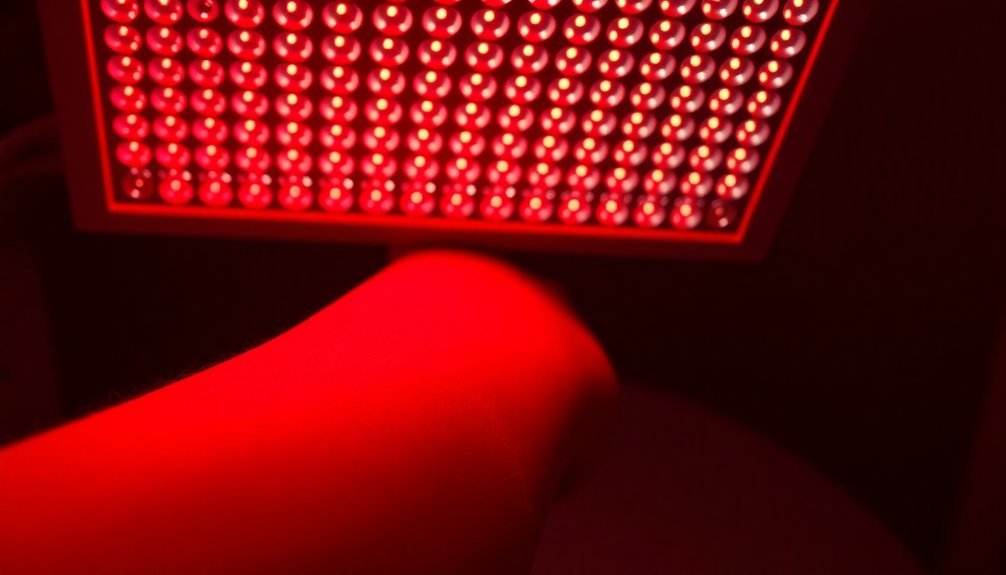
Light therapy, a revolutionary medical treatment, harnesses specific wavelengths of light to stimulate cellular processes and promote healing. When you undergo light therapy, specific wavelengths trigger cell proliferation and enhance collagen production, which are essential components for wound healing and tissue repair.
You'll find two primary light spectrums used in therapeutic treatments. Red light therapy operates between 600-700 nanometers, while near-infrared therapy uses wavelengths of 770-1200 nanometers for deeper tissue penetration. LED technology delivers these wavelengths precisely, offering non-ablative and non-thermal benefits to your healing tissues. ATP production increases when light interacts with cellular mitochondria, providing more energy for healing.
The treatment's effectiveness is backed by extensive clinical research. You'll experience reduced inflammation and improved blood circulation as the light stimulates healing at the cellular level.
Whether you're dealing with surgical incisions, burns, diabetic ulcers, or simple cuts and scrapes, light therapy can accelerate your recovery process. It's particularly effective at improving scar tissue appearance through enhanced collagen synthesis.
The treatment's intensity can be adjusted to match your specific wound type and size, ensuring you receive the most appropriate therapeutic dose for ideal healing results.
Red Light Treatment Benefits
Red light therapy boosts your body's natural healing abilities by increasing cellular energy production and stimulating fibroblast activity.
You'll notice faster wound healing as the treatment enhances blood flow and promotes the formation of new tissue rich in collagen and capillaries.
The therapy's ability to reduce inflammation while increasing cell growth makes it particularly effective for surgical recovery and burn treatment. The light penetrates 1-2 millimeters deep into skin tissue to activate cellular repair mechanisms.
Stimulates Cell Growth Naturally
Natural cellular regeneration finds a powerful ally in therapeutic red wavelengths, which stimulate your body's mitochondrial function and boost ATP production. When red light penetrates your skin, it activates cytochrome c oxidase, enhancing your cells' energy production and triggering a cascade of beneficial biological responses.
You'll experience increased fibroblast activity, which naturally boosts your collagen production and strengthens connective tissues. The light therapy promotes better circulation between your blood vessels and tissue cells, ensuring ideal oxygen delivery and nutrient transport throughout treated areas. This therapy can help reduce muscle soreness and speed up post-workout recovery.
This enhanced blood flow accelerates your body's natural healing processes.
Your cells respond to the red light wavelengths by improving their signaling pathways, leading to more efficient tissue repair and regeneration. You'll notice improvements in skin elasticity and texture as your body produces new collagen fibers.
The treatment's effects go beyond surface-level benefits – it's working at the cellular level to enhance your body's natural healing mechanisms. While you won't feel the light working, it's actively promoting tissue regeneration, reducing inflammation, and supporting your body's innate ability to heal itself through enhanced cellular function.
Accelerates Wound Repair Process
Wound healing takes a dramatic leap forward with therapeutic red light treatments, which simultaneously target multiple repair mechanisms in your body. Red light therapy accelerates healing by reducing inflammation, boosting cellular energy production, and stimulating collagen synthesis – all critical factors in the wound repair process.
When you receive red light therapy, your cells produce more ATP (cellular energy), enabling them to work more efficiently in repairing damaged tissue. The treatment's anti-inflammatory properties help reduce swelling and pain while supporting your body's natural healing processes. Treatment is most effective when using optimal wavelengths ranges between 630-940nm.
Additionally, red light therapy stimulates fibroblasts to produce more collagen, essential for wound closure and tissue regeneration.
- You'll experience faster healing of surgical incisions, reducing your recovery time
- You'll see improved results with burns and chronic wounds that haven't responded to other treatments
- You'll notice reduced scarring and better aesthetic outcomes
- You'll feel less pain and discomfort during the healing process
Scientific studies consistently show that red light therapy substantially reduces healing time across various wound types, leading to better outcomes and fewer complications compared to traditional treatment methods alone.
Choosing Your Light Therapy Device
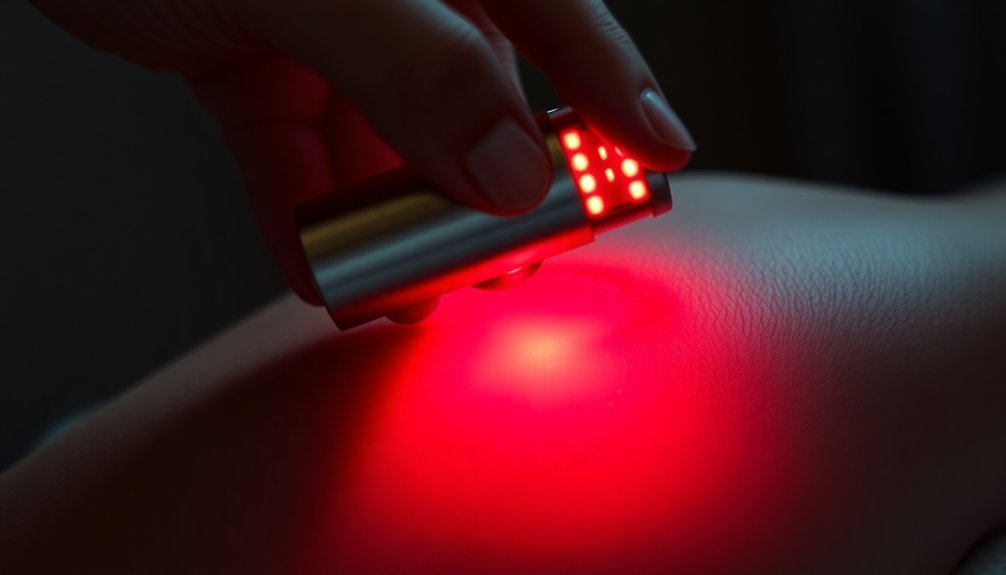
Selecting the right light therapy device requires careful consideration of wavelengths, features, and treatment goals. You'll want to focus on devices that offer red light (600-700 nm) and near-infrared light (770-1200 nm), as these wavelengths are proven effective for wound healing.
For surface-level wounds, devices with blue light (470 nm) capabilities can be beneficial. These wavelengths can help create a healthy healing environment by reducing the risk of infection in the treated area.
When evaluating devices, look for adjustable intensity settings and multiple wavelength options to treat different wound types and depths. Products like the MOVE+ Pro and LUMEBOX offer specific treatment protocols, but you'll need to match the device's capabilities to your particular healing needs.
Consider the device's portability and ease of use, as consistent daily treatments are often necessary for ideal results.
Before starting treatment, consult your healthcare provider to determine the most appropriate device and protocol. They can help you assess factors like the device's irradiance levels and recommended treatment duration.
Start with lower doses and adjust as needed. Choose devices backed by research and clear safety guidelines to verify you're getting an effective tool for your wound healing journey.
Optimal Treatment Protocols
When selecting therapeutic wavelengths for your treatment, you'll want to focus on the 760-860nm range for deep tissue work, while 600-660nm works best for surface-level concerns.
Your treatment duration should align with the specific wavelength you're using, typically ranging from 10-20 minutes per session for ideal results.
To achieve the right energy density, you'll need to take into account both the power output of your device and your target tissue depth, ensuring you deliver between 3-10 J/cm² for most therapeutic applications.
Wavelength Selection Guidelines
The ideal selection of therapeutic wavelengths depends critically on the specific healing objectives and wound characteristics you're targeting. When you're dealing with infected wounds, blue light therapy at 480 nm effectively targets pathogens, while red and near-infrared wavelengths around 730 nm stimulate cellular growth and promote wound closure.
For the best results, you'll want to think about combining different wavelength treatments. Here's why strategic wavelength selection matters:
- You'll achieve faster healing when you start with blue light to eliminate harmful bacteria, then follow up with red light to accelerate tissue repair.
- Your treatment's effectiveness doubles when you match wavelengths to specific chromophores in human tissue, ensuring maximum absorption.
- You can dramatically improve wound closure by targeting cytochrome oxidase with precise red and near-infrared wavelengths.
- Your healing outcomes improve substantially when you combine wavelength therapy with proper moisture balance and debridement.
For electromagnetic therapy, think about using 27.12 MHz frequencies to boost DNA and collagen synthesis. Remember to assess your wound type carefully before selecting wavelengths, as penetration depth and specific therapeutic needs will determine the most effective treatment protocol.
Treatment Duration Parameters
Ideal treatment duration serves as the cornerstone of successful wavelength therapy outcomes. You'll need to follow specific protocols based on your wound type and the device you're using. Most sessions range from 1 to 30 minutes, with treatments applied daily or several times weekly at regular intervals.
For chronic wounds, you'll want to implement two treatments per week, with sessions lasting 60 to 120 seconds. If you're treating venous ulcers, plan for a 4-week protocol using blue light photobiomodulation alongside standard care. Clinical studies show that venous ulcers achieve a 63.36% reduction in wound area using this treatment approach.
Surgical wounds respond well to therapeutic wavelengths when applied post-debridement, while stagnant wounds often benefit from blue light (410-430 nm) exposure.
To optimize your treatment's effectiveness, you'll need to monitor and adjust protocols based on wound assessment scores and healing progress. Keep track of pain levels and watch for signs of infection.
Always maintain the recommended distance between the device and wound surface, and verify your device is properly calibrated. You can enhance healing rates by combining wavelength therapy with standard wound care practices, such as regular dressing changes and debridement procedures.
Energy Density Considerations
Building on proper treatment timing, understanding ideal energy density requirements maximizes therapeutic wavelength effectiveness. When using blue light photobiomodulation therapy at wavelengths of 410-430 nm, you'll need to maintain a power density of 120 mW/cm² for best results.
This precise energy delivery guarantees you're providing enough stimulation for wound healing without risking tissue damage.
You'll see the best outcomes when you match energy delivery to your wound's specific needs, considering that wound healing demands approximately 20 kJ per gram of tissue deposited. For chronic wounds, you'll need to account for higher energy requirements, as these injuries often need extra support for proper healing.
- You're empowering your body's natural healing process by delivering exactly what cells need – about 60 µJ per cell
- You're preventing treatment failure by guaranteeing adequate power density reaches deeper tissue layers
- You're maximizing healing potential by matching energy delivery to your specific wound type
- You're reducing recovery time by fine-tuning the energy parameters for each treatment session
Remember to adjust your energy density based on wound depth, exudate levels, and healing stage while maintaining consistent power delivery throughout each treatment session.
Safety Considerations For Light Therapy
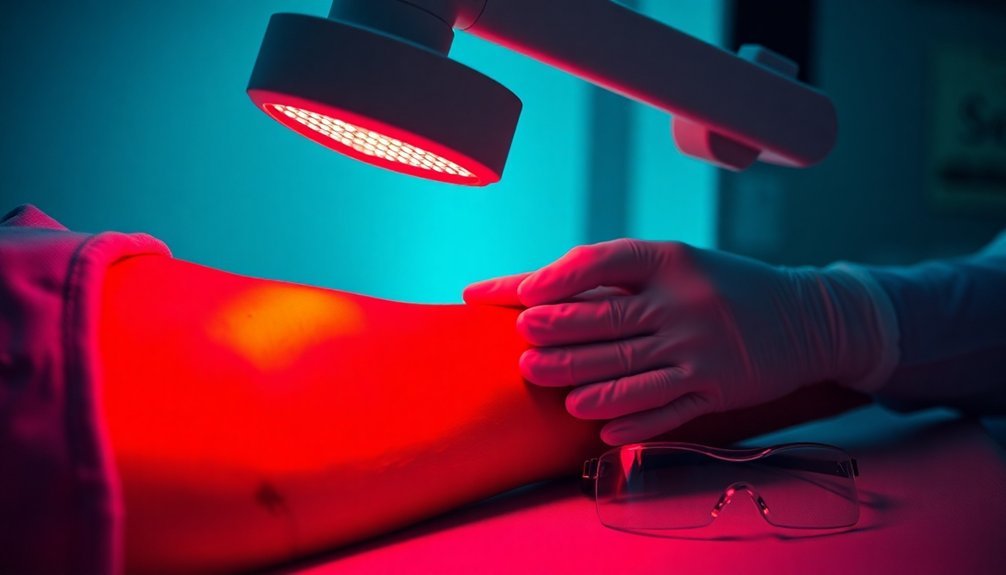
Safety considerations play a vital role in light therapy treatments, as several side effects and risks need careful management.
You'll likely experience common reactions like redness, swelling, and burning sensations at the treatment site, which typically last up to a week. The treated area may also develop scaling or crusting that can persist for up to four weeks.
To protect yourself during treatment, you must wear protective goggles to prevent eye damage. Low-level laser therapy has been shown to penetrate deeper into the skin compared to other light treatments.
If you're using photodynamic therapy, you'll need to strictly avoid direct sunlight for 48 hours afterward and apply sunblock containing zinc oxide or titanium dioxide every 2-3 hours.
If you have photosensitive skin or take photosensitizing medications, you'll need to exercise extra caution.
You should start with low doses and consult your doctor before beginning treatment. Watch for potential side effects like headaches, blurred vision, light sensitivity, or eye strain.
If you're using light therapy for SAD (Seasonal Affective Disorder), avoid evening sessions as they may disrupt your sleep patterns.
Regular ophthalmologic examinations are recommended if you're undergoing long-term light therapy treatment.
Different Wavelengths For Wound Care
While protecting yourself during light therapy is important, selecting the right wavelength for wound care directly impacts treatment success. Near-infrared and red light stand out as the most effective options, with near-infrared (800-830 nm) offering the deepest tissue penetration and most extensive healing benefits. Studies show wound healing rates improve significantly with proper wavelength selection.
You'll find that red light (630-730 nm) excels at stimulating cell growth and promoting wound closure, particularly in cases of impaired healing.
- Experience faster healing with near-infrared's powerful ability to increase blood flow and repair damaged tissue
- Trust in the proven effectiveness of red light therapy, backed by successful studies on diabetic wound healing
- Feel confident knowing you're using wavelengths that penetrate deeply enough to make real change
- Take control of your healing process with scientifically validated wavelength choices
Blue light, while less effective for wound healing, can help fight bacteria in infected wounds when used at low energy densities. Green light shows promise but needs more research to confirm its benefits.
If you're dealing with wounds, you'll want to focus primarily on near-infrared and red light treatments, as they've consistently demonstrated superior healing outcomes through enhanced cellular response and tissue repair.
Combining Therapies For Best Results
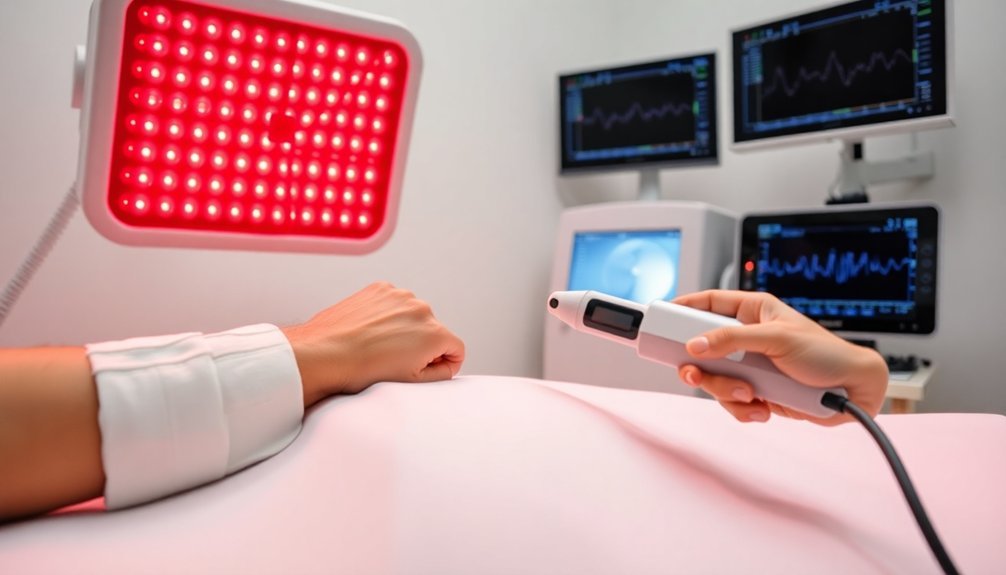
Maximizing wound healing outcomes often requires combining multiple therapeutic approaches. Studies show that when you combine different therapies, you'll achieve substantially better results than using single treatments alone.
For example, when you pair non-contact low-frequency ultrasound with standard wound care, you can heal 53% of chronic wounds compared to just 32% with standard care alone.
You'll see remarkable improvements when combining specific treatments. Adding photobiomodulation with multiple wavelengths proves more effective than single wavelength treatments.
If you're dealing with diabetic wounds, combining hydrogel with stem cells enhances neovascularization, epithelialization, and collagen synthesis.
For cirrhosis patients, a tailored combination approach can achieve healing rates of 90% in mild cases and 75% in moderate cases.
Success depends on evaluating the right combination for your specific situation. You'll need to take into account factors like initial liver function, nutritional status, and wound characteristics.
Whether you're using advanced wound dressings, negative pressure wound therapy, or hyperbaric oxygen treatment, combining these approaches strategically can substantially reduce healing time and improve overall outcomes.
Research Behind Light Treatment
Beyond combining different therapies, understanding the scientific research behind light treatment reveals its powerful healing mechanisms.
Clinical studies show that both LED and laser therapies stimulate your body's natural healing processes at the cellular level. When specific wavelengths of light penetrate your tissue, they trigger increased collagen production, enhance cell proliferation, and boost blood circulation through new vessel formation.
Research demonstrates that wavelength selection matters substantially. Red and near-infrared light excel at deeper tissue repair, while blue light proves effective for surface-level wounds. The key lies in using the right energy density – less than 20 J/cm² has been shown to stimulate ideal healing responses in your cells.
- You'll experience faster healing rates, with studies showing complete recovery in over 90% of chronic wound cases
- Your body's natural collagen production increases, strengthening new tissue formation
- You'll see reduced inflammation, creating an ideal environment for healing
- Your blood circulation improves, delivering essential nutrients to wounded areas
Clinical evidence particularly supports light therapy's effectiveness in treating diabetic wounds, where conventional treatments often fall short.
Home Treatment Best Practices
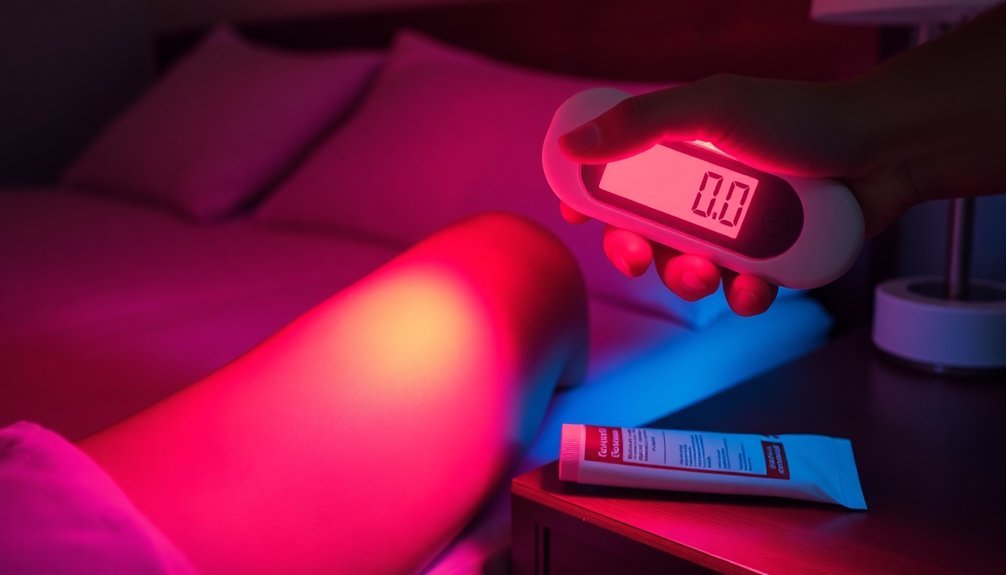
Through careful adherence to safety protocols, you can effectively manage therapeutic light treatments at home. When using therapeutic devices, you'll need to protect your eyes and monitor your skin's response to prevent damage. Don't exceed recommended exposure times, and always follow the manufacturer's guidelines for your specific device.
| Treatment Phase | Key Actions | Safety Measures |
|---|---|---|
| Pre-Treatment | Clean wound area | Check device settings |
| Application | Position device correctly | Wear protective eyewear |
| Monitoring | Watch for skin response | Track exposure time |
| Post-Treatment | Apply dressing | Document progress |
For best results, you'll want to maintain consistent treatment sessions while keeping your wound clean and properly dressed. If you're using red light therapy (RLT), combine it with appropriate wound dressings to keep the area moist and promote healing. You can enhance your treatment's effectiveness by integrating compression therapy when recommended by your healthcare provider.
Monitor your wound closely for signs of infection or complications. If you're using a mobile-connected system, track your progress through the provided app. Remember that your at-home care plan should be developed in consultation with healthcare professionals who can adjust treatments based on your healing progress.
Frequently Asked Questions
Can Light Therapy Help With Internal Wound Healing After Surgery?
Yes, you'll find light therapy can help with internal surgical healing. It penetrates deep into tissue, promoting cell regeneration, reducing inflammation, and improving blood flow, though effectiveness depends on the wound's location and depth.
How Does Altitude or Atmospheric Pressure Affect Light Therapy Effectiveness?
You don't need to worry about altitude or atmospheric pressure affecting your light therapy treatments. Research shows that light therapy's effectiveness depends mainly on the intensity and duration of exposure, not environmental conditions.
Does Skin Pigmentation Influence the Required Duration of Light Therapy?
Yes, your skin pigmentation directly affects treatment duration. If you have darker skin, you'll need shorter sessions at lower intensities, while fair skin can tolerate longer treatments due to less melanin content.
Can Therapeutic Wavelength Treatments Accelerate Healing of Tooth Extraction Sites?
Yes, you'll find that therapeutic wavelength treatments can speed up your tooth extraction healing. They'll reduce inflammation, ease pain, and promote tissue regeneration when used correctly between 660-808 nm wavelengths.
Will Light Therapy Interfere With Prescription Medications for Wound Healing?
Yes, light therapy can interfere with your prescription medications. You'll need to consult your doctor, as some medications like antibiotics and anticonvulsants may cause adverse reactions when combined with light therapy treatments.
In Summary
You'll find light therapy to be a powerful tool for accelerating wound healing when used correctly. By selecting the right wavelengths and following proper treatment protocols, you're giving your body the boost it needs to repair tissue more efficiently. Remember to always prioritize safety, maintain consistency with your treatments, and consult healthcare providers when needed. With proper application, you're well-equipped to support your body's natural healing process.

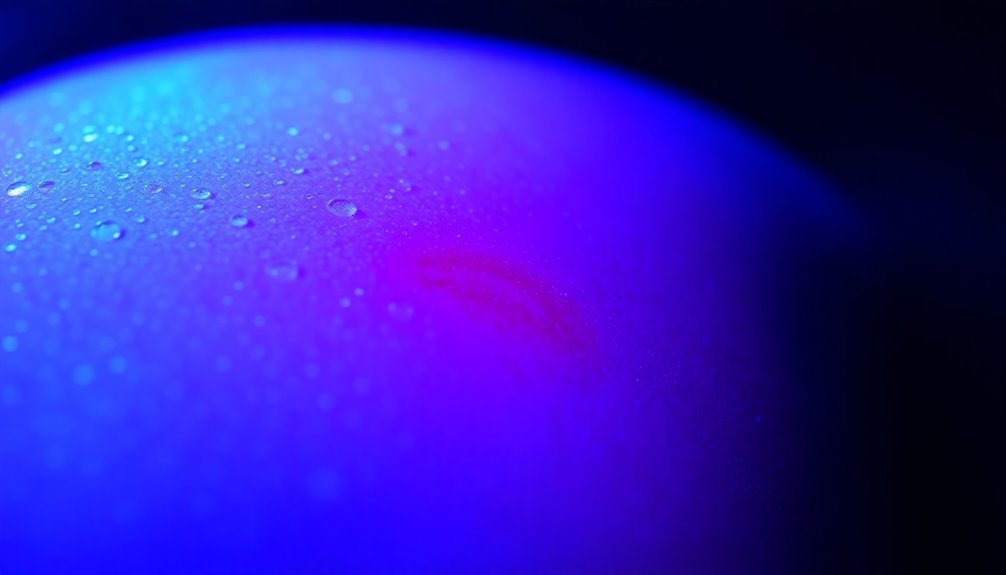



Leave a Reply